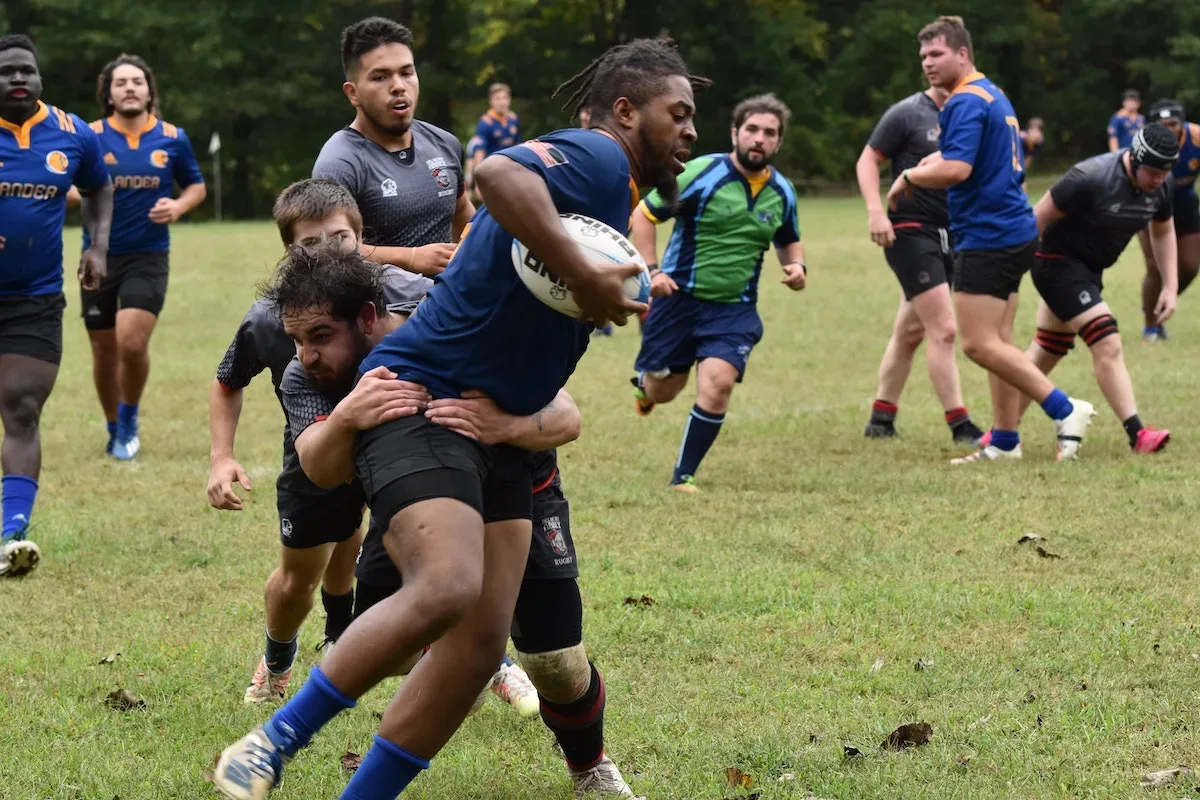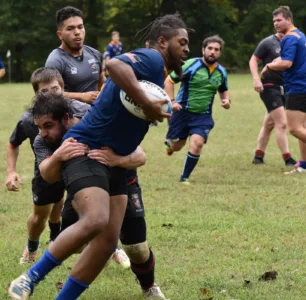Rugby is a physically demanding sport that requires a great deal of strength, speed, and agility. One of the most important aspects of the game is tackling. However, tackling can be dangerous if not done properly. In fact, improper tackle technique is one of the leading causes of injuries in rugby.
As a player or coach, it is important to understand the proper tackle technique to prevent injuries and ensure that the game is played fairly. Here are some tips on how to tackle safely and effectively:
- Focus on the ball carrier’s hips: The hips are the most important part of the body to watch when tackling. By focusing on the hips, you can predict the direction of the ball carrier and position yourself to make a strong tackle.
- Keep your head up: It is crucial to keep your head up when making a tackle. This will help you to see where the ball carrier is going and avoid head injuries.
- Wrap the arms: Wrap your arms around the ball carrier’s waist and pull them towards you. This will help to stop their forward momentum and prevent them from gaining more yards.
- Drive with your legs: Use your legs to drive the ball carrier back and take them to the ground. This will help to ensure that the tackle is strong and effective.
- Use proper form: Keep your feet shoulder-width apart, bend your knees, and keep your back straight when making a tackle. This will help to prevent injuries and ensure that the tackle is executed properly.
Coaches can also play an important role in ensuring that players use proper tackle technique. Here are some tips for coaches:
- Teach proper form: Spend time in practice teaching players the proper form for making a tackle. This will help to ensure that they are doing it correctly during games.
- Emphasise safety: Make sure that players understand the importance of tackling safely and the potential consequences of improper technique.
- Encourage communication: Players should communicate with each other on the field to make sure that they are in the best position to make a tackle.
By following these tips, players and coaches can ensure that tackling is done safely and effectively in rugby.
How does World Rugby suggest you teach proper tackle technique
World Rugby suggests that proper tackle technique can be taught through a gradual, progressive approach that focuses on developing fundamental skills before progressing to more complex activities. They recommend the following steps to teach proper tackle technique:
- Introduce tackling fundamentals: Coaches should start by teaching players the fundamental skills of tackling, such as body position, footwork, and hand placement. This can be done through drills and activities that emphasise these basic skills.
- Use safe, controlled contact activities: Coaches should gradually introduce players to controlled contact activities, such as tackling bags, to develop the skills needed to tackle safely.
- Progress to live contact: Once players have demonstrated the ability to tackle safely in controlled contact activities, coaches can introduce live contact situations. These should be done gradually and progressively, starting with low-intensity activities and increasing in intensity over time.
- Focus on technique, not strength: Coaches should emphasise the importance of proper technique over physical strength. This means teaching players to use their body position and leverage to make effective tackles, rather than relying solely on brute force.
- Reinforce safe tackling practices: Coaches should reinforce safe tackling practices in both training and game situations. This includes emphasising the importance of keeping the head up, wrapping the arms, and driving with the legs.
By following these steps, coaches can help players develop proper tackle technique in a safe and effective manner, reducing the risk of injury and promoting fair play.
The importance of pre tackle positioning in effective tackling technique
Pre tackle positioning is a crucial aspect of effective tackling technique in rugby. It refers to the positioning of the defender before making a tackle and involves getting into the correct position to make a safe and effective tackle. Proper pre tackle positioning can help to improve tackling technique, reduce the risk of injury, and increase the likelihood of making a successful tackle.
Here are some of the key reasons why pre tackle positioning is so important in effective tackling technique:
- It enables the defender to read the attacker’s movements: By getting into the right position before making a tackle, the defender can better anticipate the attacker’s movements and adjust their own position accordingly. This can help to make the tackle more effective and reduce the risk of injury.
- It allows the defender to maintain a safe distance: Effective pre tackle positioning helps the defender to maintain a safe distance from the attacker. This can help to reduce the risk of injury, as the defender is less likely to get caught up in a collision or hit by the attacker’s body.
- It improves tackling technique: Proper pre tackle positioning allows the defender to use proper technique when making a tackle, such as keeping their head up, wrapping the arms around the attacker, and driving with the legs. This can help to make the tackle more effective and reduce the risk of injury.
- It reduces the risk of penalties: Proper pre tackle positioning can help to reduce the risk of penalties, such as high tackles or dangerous tackles. By getting into the correct position before making a tackle, the defender can ensure that they are making a legal tackle that does not put themselves or the attacker in danger.
In order to develop effective pre tackle positioning, it is important for defenders to focus on their footwork, body position, and anticipation of the attacker’s movements. Coaches can also help by providing feedback and guidance during training sessions, and by emphasising the importance of pre tackle positioning in tackling technique.
Overall, pre tackle positioning is a crucial aspect of effective tackling technique in rugby. By getting into the right position before making a tackle, defenders can improve their technique, reduce the risk of injury, and increase the likelihood of making a successful tackle.
What drills can I use to perfect my Tackle technique
There are several drills that can be used to perfect tackle technique in rugby. Here are a few examples:
- Tackle bags: Tackle bags are a great tool for developing proper technique and body position during a tackle. In this drill, the player runs towards the tackle bag and makes a tackle, focusing on proper technique and driving with the legs. Coaches can also adjust the height and angle of the tackle bag to simulate different game situations.
- Sideways tackle: This drill helps players to practise tackling while moving laterally. The player starts by standing perpendicular to the coach or another player, then moves sideways to make a tackle. This drill helps to develop footwork and lateral movement, as well as proper technique when making a tackle.
- Two-on-one tackle: In this drill, two attackers try to get past one defender. The defender must use proper technique to make a tackle and prevent the attackers from scoring. This drill helps to develop decision-making skills and teamwork, as well as proper technique during a tackle.
- Tackle and get back up: In this drill, the player makes a tackle and then immediately gets back up to make another tackle. This helps to develop conditioning and the ability to quickly get back into position after making a tackle.
- Contact pad drill: In this drill, the player works on driving with their legs during a tackle. The player runs towards a contact pad and drives it backwards, focusing on keeping their head up and driving with their legs. This drill helps to develop power and leg drive during a tackle.
- Shadow tackling: In this drill, the player practices making tackles without actually making contact with another player. The player simulates a tackle by getting into the proper position and driving with their legs. This drill helps to develop muscle memory and proper technique without the risk of injury.
By incorporating these drills into training sessions, players can develop proper technique and improve their tackling skills in a safe and effective manner. Coaches can also provide feedback and guidance during these drills to help players improve their technique and make adjustments as needed.
Examples of Bad Tackle technique
Bad tackle technique in rugby can lead to serious injury for both the tackler and the person being tackled. Here are some examples of bad tackle technique that should be avoided:
- High tackle: A high tackle is one where the tackler contacts the opponent above the shoulders. This is a dangerous tackle that can cause serious head and neck injuries. It is important to keep the tackle low and aim for the waist or hips.
- Tackling with the head down: When the tackler leads with their head, they risk serious neck injuries and spinal damage. It is important to keep the head up and use the shoulder to make contact.
- Arm-only tackle: A tackle that only involves the arms is ineffective and can lead to injuries. It is important to wrap the arms around the opponent’s body and drive with the legs to bring them to the ground.
- Tackling from the side: A tackle that comes from the side can be dangerous and is often penalised in rugby. It is important to approach the opponent head-on and wrap the arms around them to make a safe and effective tackle.
- Late tackle: A late tackle is one that is made after the opponent has released the ball or scored a try. This is dangerous and can lead to penalties or disciplinary action.
- Scissor tackle: A scissor tackle is one where the tackler uses their legs to trip up the opponent. This is a dangerous tackle that can cause serious leg injuries and is illegal in rugby.
- Tackling with one arm: Tackling with only one arm is ineffective and can lead to injuries. It is important to wrap both arms around the opponent and drive with the legs to bring them to the ground.
It is important to remember that these examples of bad tackle technique can lead to serious injuries and should be avoided at all times. Proper tackling technique should be taught and practised regularly to ensure the safety of all players on the field.

